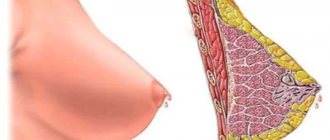Lobular breast cancer (BC) is the most common of the rare morphological variants, it occurs five times less frequently than the most common ductal one, and has significant differences that influence the choice of treatment tactics.
- What is lobular breast cancer?
- Causes and risk factors
- Symptoms of lobular cancer
- Kinds
- Diagnostic methods
- Treatment options
- Prevention of lobular breast cancer
- Forecasts
What is lobular breast cancer?
With the development of a malignant process, normal glandular tissues are replaced by tumor ones. Over time, the tumor growth increases and spreads to nearby tissues.
Cancer cells leave the malignant node and move to the lymph nodes and blood vessels. Some cells die, and those that remain functional begin to form metastases.
Through the lymphatic ducts they affect the subclavian, axillary and supraclavicular cavities. Blood vessels facilitate the transfer of pathogenic cells and their metastasis to the pelvis, uterus, lungs, spine, ovaries and liver. It may take six to ten years to reach this form.
Lobular breast cancer (BC) is quite difficult to diagnose. Even the most effective method of studying a tumor, such as mammography, turns out to be ineffective.
Methods for diagnosing and treating lobular breast cancer
The materials are published for informational purposes only and are not a prescription for treatment! We recommend that you consult an endocrinologist at your medical institution!
Co-author: Galina Vasnetsova, endocrinologist
A special form of oncology is lobular breast cancer. It is difficult to diagnose and has a variety of forms. It is detected in 20% of cases, of which about 2% are complicated, since neighboring tissues are involved in the process. The problem should be considered in more detail.
Lobular cancer is diagnosed in approximately every fifth case of malignant diseases of the mammary glands
Lobular cancer differs in that cell degeneration occurs in the lobules of the mammary gland. The disease is characterized by the formation of individual nodules. In this case, pathology can develop on one side or in both mammary glands at once.
Cancer cells attack the milk lobes
Pathology is also divided into three main types:
- Non-invasive. The least dangerous form, since in this case the malignant process is isolated and does not extend beyond the affected lobe.
- Invasive form. It is characterized by the penetration of cancer cells beyond the thoracic lobes, that is, it spreads to neighboring tissues.
- Lobular infiltrating breast cancer. The tumor spreads in a target pattern around the milk ducts.
Important: Thus, some forms of the disease can metastasize to other tissues and organs.
There is also a form of the disease known as lobular-tubular cancer, when small homogeneous cells are present along with tubular formations.
Causes
Lobular cancer can be caused by completely different factors. The main reasons are:
- diseases of the reproductive system;
- hormonal imbalances;
- early puberty;
- long-term use of oral contraceptives or other hormonal drugs;
- interrupted pregnancy;
- late birth (after 30 years);
- influence of toxic substances and ionizing radiation;
- chest injuries;
- age over 40 years;
- hereditary predisposition to tumor diseases.
Factors predisposing to the formation of cancer
The mechanism of occurrence of this type of oncology has not been sufficiently studied, so it is impossible to reliably say what exactly triggers it.
Symptoms and stages
The main difficulty of the situation is that the disease may not manifest itself for a very long period. Since there are no symptoms, the pathology can turn into an infiltrative form, and the woman will not even know about it. Only after the tumor process has spread can small lumps in the breast be detected.
Like any other type of oncology, the disease occurs in 4 stages.
Important: stage 2 invasive lobular cancer already metastasizes to the lymph nodes and neighboring tissues. That is why it is so important to identify the pathology and begin treatment before this process begins.
As the disease progresses, the lymph nodes become enlarged
Important: the difference between the invasive form is the formation of a compaction, while other forms are manifested by the presence of a “bump”.
In later stages, the following manifestations may occur:
- formation of a lump or lump in the breast;
- local redness or blanching of the skin;
- the appearance of areas of peeling, wrinkles;
- the appearance of secretion from the nipples;
- change in breast shape;
- disruptions of the menstrual cycle.
Diagnostics
It is worth remembering that lobular cancer is a breast cancer that is difficult to diagnose.
Important: with traditional approaches, the doctor conducts a physical examination, and a more accurate picture is formed after the patient undergoes a mammogram. However, for this type of disease, such methods are ineffective.
More accurate data can be obtained from the results of blood tests for specific tumor markers (triple test). You also need to evaluate the general condition of the breast so as not to miss the presence of other tumor formations. Mammography, ultrasound, MRI and CT are used for this. The diagnosis can be confirmed or refuted only after a biopsy.
X-ray of the non-invasive lobular form of the disease
Important: when conducting biopsy studies, the degree of receptor activity in relation to estrogen is assessed. The lobular type of cancer belongs to the category of hormone-dependent.
Treatment methods
Since lobular cancer interacts with hormonal drugs, special medications are selected for treatment. Hormonal therapy is combined with chemotherapy, radiation therapy, and biological therapy.
As long as the disease has not become invasive, an excisional biopsy can be performed. The essence of this procedure is to eliminate the tumor along with some healthy adjacent tissue. If there is a risk of developing bilateral cancer, a mastectomy may be performed. In this case, the mammary gland is completely removed. In the future, its shape can be restored through plastic surgery using silicone implants.
Excisional biopsy is performed under ultrasound guidance
If lobular breast cancer with metastases has been diagnosed, it is necessary to undergo a course of chemotherapy. Radiation therapy is needed to more effectively destroy cancer cells. If it penetrates the lymphatic system, removal of the affected lymph nodes is indicated, if at this stage this is still possible.
Prognosis and prevention
When diagnosed with lobular breast cancer, the prognosis depends on its form. The non-invasive type of the disease is quite treatable. It can be eliminated using conservative methods or excisional biopsy. Thanks to this, it is possible to achieve a high ten-year survival rate of more than 95%.
Timely treatment provides a high chance of recovery
Infiltrating, invasive cancer are more complex cases. It is much more difficult to get rid of pathology as it progresses, so an accurate prognosis can only be made after diagnosing the specific type and degree of the disease.
To prevent cancer, it is necessary to undergo regular examinations by a mammologist. This is especially true for patients at risk. It is also important to minimize the influence of external negative factors (ecology, bad habits) and internal (diseases, hormonal imbalances, tissue inflammation).
Co-author: Galina Vasnetsova, endocrinologist
Rate the material
pozhelezam.ru
Classification
Lobular carcinoma is divided into several types.
Non-invasive
This form of lobular cancer is one of the earliest. In this case, the cancer has not yet transferred to the tissues that are located next to the affected area. The localization of such a tumor is noted in one lobe of the gland. If the disease is detected in a timely manner and treated, the prognosis will be quite successful.
Invasive
The disease is a process in which a cancerous tumor spreads to nearby tissues. This form of pathology is more aggressive.
Treatment for invasive lobular carcinoma is more complex. The consequences are not very comforting. Diagnosis of invasive cancer is observed somewhat less frequently, in contrast to the first form. The initial stages of the disease are asymptomatic, later stages are manifested by compaction.
Infiltrating
This form is becoming more common. Refers to the late stage, which is characterized by localization of the tumor tumor near the ducts.
Infiltrative lobular breast cancer is characterized by rare metastasis to the lymph nodes. The main goal of therapeutic measures is to achieve long-term remission.
The peculiarity of the invasive form of cancer of the 2nd degree of malignancy is the spread of metastases to neighboring tissues and lymph nodes. It is for this reason that it is necessary to identify the pathological process as early as possible and begin measures to eliminate it.
Stages
At the first stage, breast cancer does not yet extend beyond the primary area of localization, and therefore is not infiltrative. This type of breast cancer begins only from stage g2, that is, from the second.
Each stage has its own differences:
- The second is that metastases can affect from one to three lymph nodes in the armpit area on the side of the disease. The circumthoracic lymph nodes also become enlarged and begin to hurt.
- Third, four to nine axillary lymph nodes are affected. In addition, lymphadenitis begins inside the chest.
- Fourth - metastases spread to ten or more lymph nodes in the armpits. The tumor also metastasizes to the lymph nodes under the collarbones, and along with the lymph flow, the tumor cells disperse throughout the body.
The earlier infiltrative cancer is detected, the greater the chance of recovery. That is why you need to consult a doctor immediately if any changes begin in your chest.
Causes
To date, the main provoking factors of cancer have not been established. In most cases, among the most common causes of lobular cancer, experts identify:
- hereditary predisposition;
- menopause after reaching 55 years of age;
- late birth;
- refusal to breastfeed ;
- early onset of menstruation in girls (up to 12 years);
- abortions;
- excessive consumption of alcoholic beverages;
- injury to the mammary glands;
- frequent stressful situations;
- pathologies of the endocrine system;
- excess weight ;
- an increase in the concentration of cholesterol in the blood fluid.
The main reason for the development of lobular carcinoma is the use of hormonal drugs over a long period of time. This also includes cases where medications were used for contraception.
Causes of breast cancer development
The exact reasons for the mutation of epithelial and glandular cells are unknown. Heredity plays a big role in this.
Gene mutations
The body has natural mechanisms that are responsible for repairing damaged DNA, regulating cell growth, preventing cells with damaged DNA from dividing, and killing them by triggering apoptosis (cell death).
Gene mutations disrupt these natural processes. In particular, mutations of the BRCA1, BRCA2 genes, which are responsible for DNA repair and prevent the development of cancerous tumors, create a serious risk of developing cancer.
In the presence of such mutations, its probability is up to 80%. This is associated with the high popularity of preventive mastectomy operations (removal of the mammary gland) when congenital mutations of the BRCA genes are detected.
Another gene, HER2/neu, is responsible for producing a protein necessary for cell growth and division. When it mutates, a phenomenon called overexpression occurs - the gene triggers the excessive production of the HER2 protein, which leads to accelerated cell division and the formation of malignant tumors.
The TP53 gene is responsible for destroying cells with damaged DNA. Its mutations also serve as a factor in the development of breast cancer.
Mutations of the ATM, PTEN, CHEK2, STK11, CDH1, PALB2 genes can play a significant role in the development of the disease.
These mutations are determined by molecular genetic testing of a tumor sample. Based on the tests, a decision is made on the use of one or another type of hormonal or targeted therapy.
Most types of breast cancer are hormone-dependent tumors. The risk of developing the disease increases with sudden hormonal changes and hormonal imbalances (estrogen and progesterone levels).
Factors in the development of the disease include:
- Female. Infiltrative breast cancer usually occurs in women. Men suffer from it in extremely rare cases, due to hormonal disorders.
- Age. Most cases of malignant disease occur in women between 40 and 50 years of age.
- Early (before 12 years of age) menarche is the first menstruation. Early puberty.
- Late onset of menopause (after 55 years).
- Consolidation of breast tissue.
- Obesity. Large fat deposits can play the role of an independent internal secretion organ and influence hormone levels. This can become a factor in the development of hormone-dependent breast tumors.
- Hormonal therapy. Typically, hormone replacement therapy is used in the treatment of menopausal syndrome, as well as a number of other diseases. Its impact on the likelihood of developing cancer is especially high during menopause.
- Late first birth (after 40 years).
- Abortion.
- Refusal of breastfeeding. During pregnancy and lactation, hormonal changes occur in the female body, and during lactation, changes in breast tissue occur. Violent intervention or ignoring these processes can lead to consequences in the form of a malignant tumor. As a result, ductal or lobular breast cancer develops.
- Lack of pregnancy and/or childbirth.
- Lack of sex life. Irregular sex life or its absence negatively affects a woman’s hormonal status.
In addition, a significant factor in the development of infiltrative breast cancer is a negative family history—the presence of the disease in close relatives.
Nervous stress can also provoke the development of hormone-dependent malignant tumors, since a woman’s hormonal system depends on the state of her nervous system and psycho-emotional state.
How to identify breast cancer June 2, 2019105048 4563
Symptoms
Lobular breast cancer has virtually no clinical symptoms, which makes it difficult to diagnose the disease during examination. This is explained by the same density of glandular tissue and tumor neoplasm. As a result, the tumor tends to grow to large sizes by the time it can be detected.
On this topic
- Oncomammology
Breast puncture
- Natalya Gennadievna Butsyk
- November 29, 2021
When the pathological process transitions to an invasive form, signs such as:
- compacted formations with unclear contours, having a certain mobility;
- nodules that form singly or in groups;
- an increase in the size of lymph nodes;
- changes in the shape, size and configuration of the mammary gland when contacting a specialist at later stages of the disease;
- hyperemia of the chest surface;
- pale skin;
- wrinkling .
If during the examination an indeterminate node was discovered, then you must immediately visit a medical institution, where an examination by a mammologist or oncologist will be carried out. Since such a symptom may indicate lobular carcinoma.
Diagnostics
To diagnose lobular carcinoma, in addition to examining the mammary glands by a specialist, additional examinations are prescribed.
Mammography
This method in itself is not effective, but it makes it possible to differentiate the pathology from other types of cancer.
Blood analysis
Laboratory diagnosis involves studying the tumor marker HER-2/neu in the blood fluid. Thanks to him, it is possible to establish existing deviations from normal values.
Biopsy
The technique consists of collecting biological material using a special syringe in the place where the tumor process is expected to be localized. After taking a sample, it is examined in a laboratory.
Ultrasound of the mammary glands
This diagnostic method makes it possible to determine the location of the malignant neoplasm.
Checking estrogen levels
Lobular carcinoma is a disease that is directly related to hormones. It is for this reason that there is a need for their differential diagnosis.
Radiography
Allows you to determine how far the metastases have spread.
Also, if necessary, magnetic resonance and computed tomography may be prescribed.
Invasive lobular cancer can often be diagnosed late, when the tumor is already quite large. This is associated not only with the characteristics of tumor growth, but also with the difficulties that arise when using mammography.
Diagnosis of breast cancer
At the appointment, the doctor conducts an external examination, palpates the breast, and asks the patient about the symptoms of the disease. If cancer is suspected, a comprehensive examination is carried out.
- Ultrasound.
Ultrasound examination (ultrasound) of the mammary gland shows the presence of a tumor, its size, location, and blood supply. An ultrasound of the liver and abdominal cavity is also performed to check for metastases. - Mammography.
A breast x-ray shows the structure of the tumor tissue and helps clarify the boundaries of the tumor. - Ductography.
X-rays using a contrast agent allow better visualization and examination of the milk ducts and the spread of the tumor in ductal cancer. - Biopsy.
A sample of tumor tissue is collected under ultrasound guidance using a thin needle. After this, the biopsy specimen is subjected to histological (immunohistochemical, molecular genetic) examination under a microscope. - PAT.
Positron emission tomography shows the spread of cancer cells in invasive breast cancer beyond the primary tumor site. - Scintigraphy.
If bone metastases are suspected, osteoscintigraphy is used. - MRI.
Magnetic resonance imaging is used to clarify diagnostic data (tumor tissue structure, soft tissue invasion), as well as to detect metastases in the liver, lungs, and lymph nodes. - CT scan.
CT is used to detail the structure of the tumor, clarify its size and spread. - Biomarkers.
Invasive breast cancer is a hormone-dependent tumor. Therefore, when diagnosing it, estrogen receptors (ER) and progesterone receptors (PR) are examined. This allows us to determine the possibilities of hormone therapy. Mutations of the BRCA1 and BRCA2 genes are also studied to assess the likelihood of disease relapse and determine the extent of surgical intervention. In addition, HER2 protein testing is done to evaluate the involvement of HER2/neu gene overexpression and the possibility of targeted therapy.
Treatment
In modern medicine, various means are used that are aimed at eliminating the cancer process. Each of them has its own characteristics, efficiency and volume of work of specialists.
Surgery
Like any malignant tumor, lobular cancer first undergoes surgical intervention. Depending on the stage of prevalence of the neoplasm in the gland, one or two surgical methods can be used.
A lumpectomy is a process in which a scalpel is passed through healthy tissue parallel to the edge of the tumor.
During a mastectomy, the entire affected breast is removed.
On this topic
- Oncomammology
Ovariectomy for breast cancer
- Natalya Gennadievna Butsyk
- November 29, 2021
If lumpectomy fails to remove the entire tumor, additional surgery is performed. Sometimes the breast has to be removed completely.
The peculiarity of invasive lobular carcinoma is that it can affect several areas at once. In such situations, specialists often insist on performing a mastectomy.
Which surgical method to choose will depend on several factors, which include:
- stage of the pathological process;
- number of lesions ;
- location of the tumor;
- dimensions;
- the goal of organ preservation.
Contraindications to the operation are:
- diabetes ;
- renal and liver failure;
- pathologies of the heart and blood vessels;
- circulatory disorders in the brain;
- ingrowth of a tumor into the chest.
If several nodes are diagnosed, the tumor is of impressive size, or the tumor process is spreading rapidly, then it is not possible to save the affected organ.
Chemotherapy
In the treatment of lobular breast carcinoma, in most cases, standard treatment regimens (CAF, TAC, CMF and AC) are used. However, with this disease their effectiveness is not enough. In this case, additional clinical measures are carried out to identify the most optimal combinations of cytostatics that will be useful in the treatment of invasive lobular cancer.
Radial
The technique is used after surgery. This is necessary to make sure that all cancer cells are destroyed, since the operation does not provide a 100% guarantee of this.
The method has a destructive effect on the cancerous tumor, which prevents it from recovering in the future. With this therapy, the prognosis is most often favorable.
Hormonal
If there are estrogen receptors in tumor cells, their growth will be influenced by this particular hormone. In such cases, specialists prescribe hormonal drugs that will block tumor cells. Among the most popular drugs are Exemestane, Tamoxifen, Letrozole, and Goserelin.
Treatment with hormones is indicated for:
- a small number of metastases;
- reaching of 55 .
In addition, therapeutic measures are carried out in case of long-term remission.
Immunotherapy
It is a young direction in the treatment of lobular breast cancer. The procedure consists of introducing into the female body drugs of biological origin that have antitumor activity.
The process of fighting cancer cells occurs. As soon as the tumor stops feeding, the oncological process is blocked.
The production of such drugs is carried out individually in each case. They are taken from a sample of cellular material, the substance is processed and introduced into the patient’s body. This technique increases the prognosis for recovery several times.
Treatment methods for infiltrative cancer
Using a histological and molecular genetic study, the doctor determines the sensitivity of the tumor to hormones, as well as gene mutations that enable targeted therapy.
Chemotherapy
Chemotherapy drugs are used to shrink the tumor before surgery or to kill remaining cancer cells after surgery. For inoperable tumors, chemotherapy is used to slow the progression of the disease as part of palliative therapy.
Indications for the use of chemotherapy for infiltrative breast cancer:
- large tumor sizes (more than 2 cm),
- 2 or 3 degree of disease,
- the patient's age is younger than 35 years,
- the presence of metastases in the lymph nodes.
Surgical intervention
Relatively recently, the only surgical treatment for infiltrative breast cancer was its complete removal. However, today surgeons are inclined to perform organ-saving operations, in which only the tumor itself is excised within healthy tissue.
The decision to excise regional lymph nodes is made on the basis of a sentinel biopsy. A radio-drug is injected into the tumor, with the help of which the nearest lymph node is detected. It's called a guard.
This lymph node is excised and examined for the presence of cancer cells. If they are not present, the remaining lymph nodes are not removed. If they are present, the next lymph node is examined.
Excision of lymph nodes can lead to a complication in the form of lymphedema (lymphostasis), so it is resorted to only if necessary.
If breast-sparing surgery is not possible, the tumor is large, or there is a high risk of recurrence, the mammary gland is removed completely. This operation is called a mastectomy. The areola and nipple are usually preserved.
After this, reconstructive mammoplasty is performed, the removed breast is recreated with a silicone implant, and its external attractiveness is preserved.
Surgical treatment of infiltrative breast cancer may include removal of not only glandular tissue, fatty tissue and lymph nodes, but also the affected pectoral muscles.
Hormone therapy
Hormonal drugs are used to treat tumors with high sensitivity to estrogens and progesterone.
Targeted therapy
Targeted therapy drugs affect factors of cell division, tumor growth, and the formation of its blood supply system. Sensitivity to such drugs is determined by molecular genetic testing of a tumor sample.
Unlike chemotherapy, targeted therapy drugs act selectively on individual groups of cells, and therefore produce much fewer side effects.
Radiation therapy
The indications for the use of radiation therapy for the treatment of infiltrative breast cancer are the same as for chemotherapy.
It is used before surgery to reduce the size of the tumor or after it to minimize the risk of relapse and destroy metastases and remaining cancer cells.
The source of radiation can be external or it can be radioactive granules that are placed near the tumor. In the second case, the method is called brachytherapy. This is a more gentle treatment method in which only a small area is irradiated. This helps reduce the side effects of radiation therapy.
At a later stage, radiation therapy is used in combination with chemotherapy to slow tumor development and reduce symptoms for palliative purposes.
Homeopathy
Homeopathic medicines are used for rehabilitation after surgery, accelerating recovery, strengthening the immune system, and also as a means of preventing relapses of the disease.
Possible complications
If measures are not taken in a timely manner to eliminate the malignant process, this can lead to even more serious consequences. First of all, metastases will begin to form, which can affect the lymph nodes, armpit area or healthy breast.
Metastasis also spreads to the lungs, spine, hip bones or ribs. The process may involve the brain, appendages, liver and adrenal glands.
In addition, the motor function of the shoulder area, which is located on the side of the affected chest, is impaired. Lymphostasis of the arm cannot be excluded.
The disease can recur after 5-10 years.
Forecast
Several factors will influence life expectancy. These include:
- therapeutic used ;
- the age category to which the patient belongs;
- form and degree of development of pathology;
- size of the tumor.
If lobular cancer is diagnosed at an early stage, the prognosis is good. To achieve complete recovery, the tumor should not exceed two centimeters in size.
When a cancer process is detected at stages 1-2 of development, life expectancy is more than five years in 90 percent of cases. At stage 3, survival is about three years after completing a course of therapy.
Cancer of the infiltrating and invasive form is the most severe. It is possible to make accurate predictions in this case only after conducting a diagnostic examination and establishing the degree and type of the disease.
Disease stages and differentiation
At stage 1
invasive breast cancer, the tumor size does not exceed 2 cm. There is no invasion (sprouting) into neighboring tissues, there are no metastases. The disease usually does not show symptoms at this stage.
At stage 2
The tumor size reaches 5 cm, but there are no regional metastases or invasion yet. Or the size of the tumor remains within 2 cm, but there are metastases in the regional (axillary) lymph nodes.
At stage 3
skin symptoms appear. There are multiple metastases in regional lymph nodes, invasion into surrounding tissue, and the chest.
At stage 4
there are metastases in distant organs.
The degree of malignancy of the tumor is determined by its histological examination. The less cancer cells differ from normal ones, the lower the rate of their division, and the lower the degree of malignancy of the tumor.
G1
— cancer cells have a high degree of differentiation, the tumor grows slowly, and metastases usually do not form.
G2
—medium degree of differentiation.
G3
- low degree of differentiation, the tumor has a high degree of malignancy.
G4
is an undifferentiated tumor, the cells of which no longer have anything in common with normal ones; they quickly divide and are extremely dangerous for metastasis.
Stages of breast cancer November 21, 20201845 2










